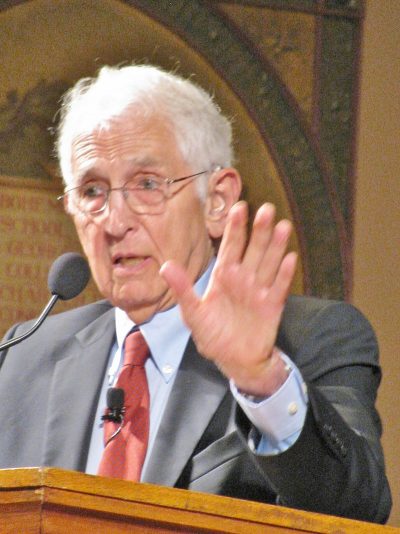U.S. Military Planned First Strike Nuclear Attack on Every City in Russia and China… and Gave Many Low-Level Field Commanders the Power to Push the Button
Interview with Daniel Ellsberg

Daniel Ellsberg – America’s most famous whistleblower, the former military analyst who leaked the Pentagon Papers which helped end the Vietnam war – has just published a book revealing that he was also one of the main nuclear war planners for the United States in the 1960s.
Ellsberg said in an interview this morning on Democracy Now that the U.S. had plans for a first strike on every city in Russia and China … and that numerous field-level commanders had the power to start nuclear Armageddon:
[Interviewer] So, you made copies of top-secret reports for plans about nuclear war years before you copied the Pentagon Papers—DANIEL ELLSBERG: That’s right.[Interviewer] —and released them to the press?DANIEL ELLSBERG: Essentially, my notes, and sometimes verbatim excerpts, not the entire plans themselves, but on plans that were then unknown to the president, to begin with, to President Kennedy. I briefed his aide, McGeorge Bundy, in his first month in office on the nature of the plans and some of the other problems, like the delegation of authority to theater commanders for nuclear war by President Eisenhower, which was fairly shocking to McGeorge Bundy, even though Kennedy chose to renew that delegation, as other presidents have. [This confirms what Michel Chossudovsky alleged in Towards a World War III Scenario: that the U.S. is so enamored with nuclear weapons that it has authorized low-level field commanders to use them in the heat of battle in their sole discretion … without any approval from civilian leaders.]But I was given the job of improving the Eisenhower plans, which was not a very high bar, actually, at that time, because they were, on their face, the worst plans in the history of warfare. A number of people who saw them, but very few civilians ever got a look at them. In fact, the joint chiefs couldn’t really get the targets out of General LeMay at the Strategic Air Command.And there was a good reason for that: They were insane. They called for first-strike plans, which was by order of President Eisenhower. He didn’t want any plan for limited war of any kind with the Soviet Union, under any circumstances, because that would enable the Army to ask for enormous numbers of divisions or even tactical nuclear weapons to deal with the Soviets. So he required that the only plan for fighting Soviets, under any circumstances, such as an encounter in the Berlin corridor, the access to West Berlin, or over Iran, which was already a flashpoint at that point, or Yugoslavia, if they had gone in—however the war started—with an uprising in East Germany, for example—however it got started, Eisenhower’s directed plan was for all-out war, in a first initiation of nuclear war, assuming the Soviets had not used nuclear weapons.And that plan called, in our first strike, for hitting every city—actually, every town over 25,000—in the USSR and every city in China. [Ellsberg isn’t the first to discuss U.S. plans for a nuclear first strike. In the 1986 book To Win a Nuclear War: The Pentagon’s Secret War Plans, one of the world’s leading physicists – Michio Kaku – revealed declassified plans for the U.S. to launch a first-strike nuclear war against Russia. The forward was written by former U.S. Attorney General Ramsey Clarke.] A war with Russia would inevitably involve immediate attacks on every city in China. In the course of doing this—pardon me—there were no reserves. Everything was to be thrown as soon as it was available—it was a vast trucking operation of thermonuclear weapons—over to the USSR, but not only the USSR. The captive nations, the East Europe satellites in the Warsaw Pact, were to be hit in their air defenses, which were all near cities, their transport points, their communications of any kind. So they were to be annihilated, as well.***
The weapons, the machinery that will carry this out, this was no hypothetical plan, like Herman Kahn might have conceived at the doomsday machine that he thought up at the RAND Corporation as my colleague. This was an actual war plan for how we would use the existing weapons, many of which I had seen already that time.***Every president has delegated. I don’t know the details of what President Trump has done or since the Cold War. Every president in the Cold War, right through Carter and Reagan, had delegated, in fact, to theater commanders in case communications were cut off. That means that the idea that the president is the only one with sole power to issue an order that will be recognized as an authentic authorized order is totally false.How many fingers are on buttons? Probably no president has ever really known the details of that. I knew, in ’61, for example, that Admiral Harry D. Felt in CINCPAC, commander-in-chief of Pacific, for whom I worked as a researcher, had delegated that to 7th Fleet, down to various commanders, and they, in turn, had delegated down to people. So when you say, “How many altogether feel authorized?” if their communications are cut off—and that happened part of every day in the Pacific when I was there—communications got better, but the delegations never changed.****Generally, they allow for lower-level majors, colonels to decide, “The time has come. We’ve lost our commanders. The time has come to go.”
The original source of this article is Washington's Blog




Geen opmerkingen:
Een reactie posten